【Cesium 顏狗初步】fabric 材質定義與自定義著色器實踐
阿新 • • 發佈:2020-12-15
fabric 材質定義:著色器實踐
# 1. 示例程式碼
貼到沙盒裡就可以執行:
``` JS
var viewer = new Cesium.Viewer("cesiumContainer");
viewer.scene.globe.depthTestAgainstTerrain = true;
viewer.camera.setView({
destination : new Cesium.Cartesian3(-2644963.9889313546, 5763731.142118295, 2199400.7089496767), //世界座標系下的一個座標點
orientation : {//旋轉角度
heading :6.075,
pitch :-0.727,
roll : 6.283
}
});
const extrudedPolygon = new Cesium.PolygonGeometry({
polygonHierarchy : new Cesium.PolygonHierarchy(
Cesium.Cartesian3.fromDegreesArray([
112.41726298378288, 23.290411251106182,
113.67072522399741, 23.560312361463682,
114.09370956893551, 22.590768298743153,
112.83803246418894, 22.285610818885644
])
),
extrudedHeight: 3000
});
const instance = new Cesium.GeometryInstance({
geometry: extrudedPolygon,
id: 'box with height'
});
const m = new Cesium.Material({
fabric: {
type: 'Color',
uniforms: {
color: new Cesium.Color(216 / 255.0, 170 / 255.0, 208 / 255.0).withAlpha(0.618),
},
}
});
const aper = new Cesium.MaterialAppearance({
material : m,
});
var p = viewer.scene.primitives.add(new Cesium.Primitive({
geometryInstances: instance,
appearance: aper,
releaseGeometryInstances: false,
compressVertices: false,
}));
// p.readyPromise.then(v => console.log(v));
const vs = aper.vertexShaderSource;
const fs = aper.fragmentShaderSource;
const fs2 = aper.getFragmentShaderSource();
console.log(`// 頂點著色器:
${vs}`);
console.log(`// 片元著色器:
${fs}`);
console.log(`// 片元著色器2:
${fs2}`);
```
# 2. 修改 fabric 物件
``` js
const m = new Cesium.Material({
fabric: {
source: `float a = 12.0;`,
}
});
```
隨便定義一個浮點數,發現報錯:
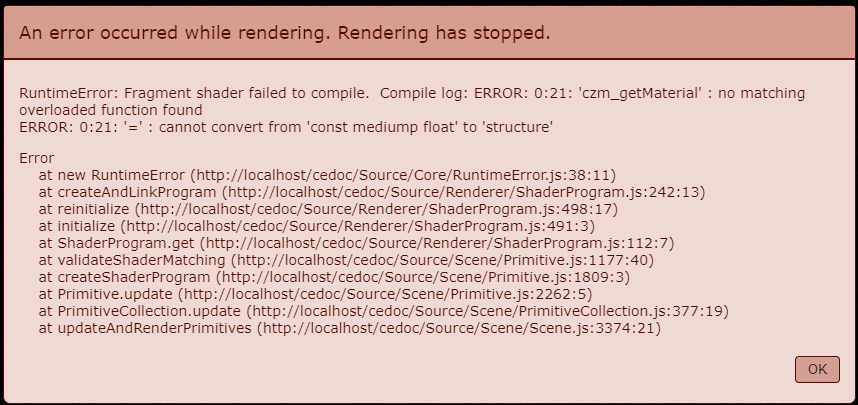
加上 `uniform` 限定字,報錯稍微改了一點:
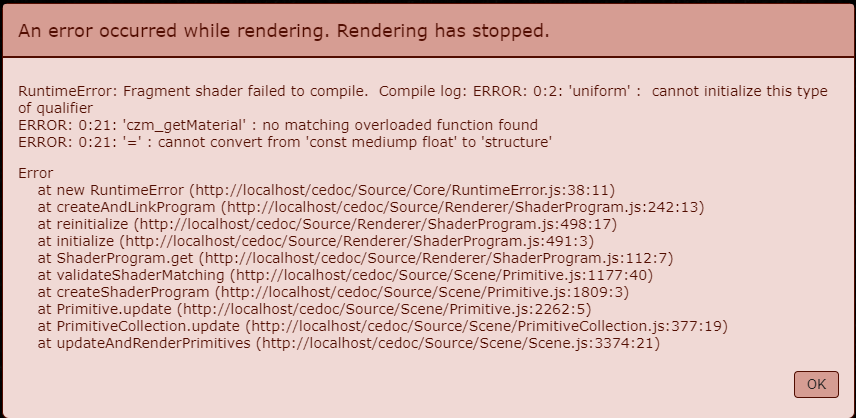
所以,這個 source 是有規則的。
## 2.1. 必須擁有函式 czm_getMaterial(czm_materialInput materialInput)
我改成這樣:
``` JS
source:
`czm_material czm_getMaterial(czm_materialInput materialInput)
{
}`,
```
報錯變化了:
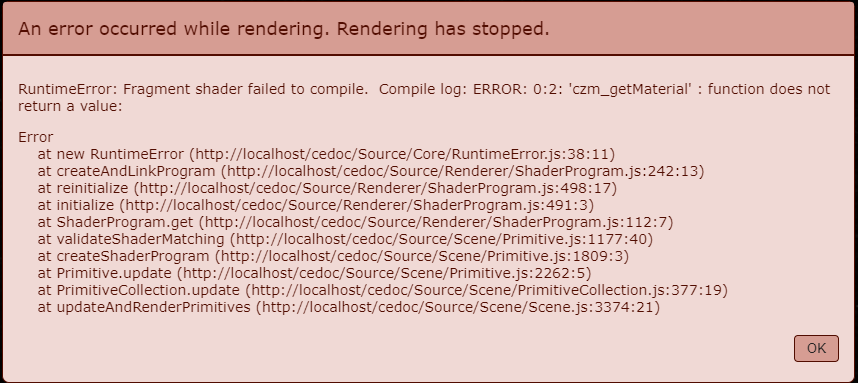
大意是指,`czm_getMaterial` 這個函式沒有返回值。這很正常,強型別的 GLSL 規定了這個函式的返回值型別是結構體 `czm_material`,那麼再次修改它。
## 2.2. 必須有返回值:不妨返回個預設值
``` JS
source:
`czm_material czm_getMaterial(czm_materialInput materialInput)
{
czm_material material = czm_getDefaultMaterial(materialInput);
return material;
}`,
```
這時,形狀有顏色了:
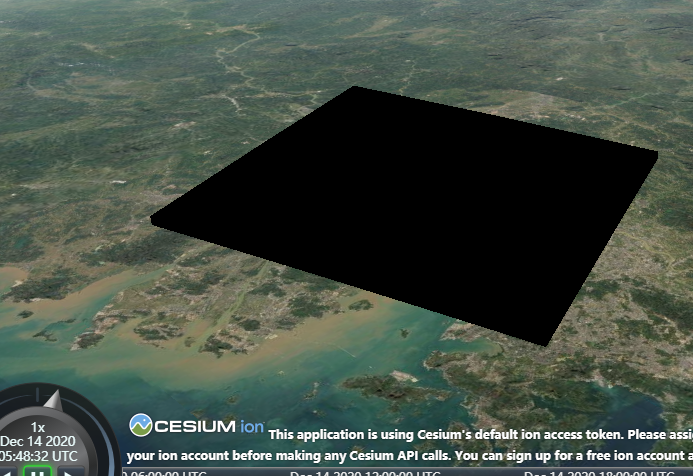
material 這個變數是一個結構體,通過修改其材質因子即可實現材質修改。
修改其漫反射因子:
注意,glsl 中建立結構體 vec3 的預設值是 (0, 0, 0),現在我想要個粉色,rgb色值是:(216 / 255.0, 170 / 255.0, 208 / 255.0),即 (0.8470588235294118, 0.66666666, 0.8156862745098039)
``` JS
source:
`czm_material czm_getMaterial(czm_materialInput materialInput)
{
czm_material material = czm_getDefaultMaterial(materialInput);
material.diffuse = vec3(0.8470588235294118, 0.66666666, 0.8156862745098039);
return material;
}`,
```
沒毛病,顏色出來了:
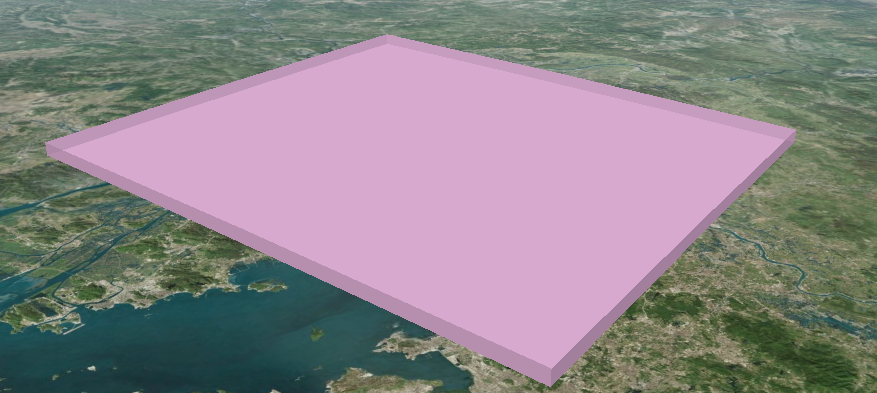
## 2.3. 頂點著色器與片元著色器
你可以在很多個地方獲取材質、外觀的著色器原始碼:
- Material.prototype.shaderSource:可讀可寫:當前 material 物件的 source 屬性,支援實時修改
- Appearance.prototype.vertexShaderSource:只讀:當前外觀物件的頂點著色器,僅支援構造時傳入
- Appearance.prototype.fragmentShaderSource:只讀:當前外觀物件的片元著色器,僅支援構造時傳入
- Appearance.prototype.getFragmentShaderSource():返回最終完全版片元著色器原始碼。
上面在 fabric 物件中的 source 屬性指定的 glsl 原始碼,與 console.log(m.shaderSource) 出來的是完全一樣的,所以此處忽略。
當通過 2.2 節中對漫反射屬性的設定後,外觀物件的 `vertexShaderSource` 和 `fragmentShaderSource` 輸出結果如下:
``` glsl
// 頂點著色器:
attribute vec3 position3DHigh;
attribute vec3 position3DLow;
attribute vec3 normal;
attribute vec2 st;
attribute float batchId;
varying vec3 v_positionEC;
varying vec3 v_normalEC;
varying vec2 v_st;
void main()
{
vec4 p = czm_computePosition();
v_positionEC = (czm_modelViewRelativeToEye * p).xyz; // position in eye coordinates
v_normalEC = czm_normal * normal; // normal in eye coordinates
v_st = st;
gl_Position = czm_modelViewProjectionRelativeToEye * p;
}
```
``` glsl
// 片元著色器:
varying vec3 v_positionEC;
varying vec3 v_normalEC;
varying vec2 v_st;
void main()
{
vec3 positionToEyeEC = -v_positionEC;
vec3 normalEC = normalize(v_normalEC);
#ifdef FACE_FORWARD
normalEC = faceforward(normalEC, vec3(0.0, 0.0, 1.0), -normalEC);
#endif
czm_materialInput materialInput;
materialInput.normalEC = normalEC;
materialInput.positionToEyeEC = positionToEyeEC;
materialInput.st = v_st;
czm_material material = czm_getMaterial(materialInput);
#ifdef FLAT
gl_FragColor = vec4(material.diffuse + material.emission, material.alpha);
#else
gl_FragColor = czm_phong(normalize(positionToEyeEC), material, czm_lightDirectionEC);
#endif
}
```
### 捕獲重點:片元著色器
觀察片元著色器程式碼中的主函式,其中有一句呼叫 `czm_material material = czm_getMaterial(materialInput);`
這一句便是對我們在 fabric 物件中寫入的 glsl 程式碼的呼叫。
最終,進入 `#ifdef FLAT` 分支(才疏學淺,不知道這個 FLAT 巨集是什麼),對畫素著色,使用 material 結構的漫反射因子 + 自發光因子 + 透明度因子進行疊加,生成最終的顏色值。所以,這個時候不妨回到 Material 的 source 中,繼續動手腳。
> 是存在直接修改 Appearance 物件 fragmentShader、vertexShader 的大佬的,後面有機會展開說說。
## 2.4. 牛刀小試:發個光吧
``` js
source:
`czm_material czm_getMaterial(czm_materialInput materialInput)
{
czm_material material = czm_getDefaultMaterial(materialInput);
material.diffuse = vec3(0.8470588235294118, 0.66666666, 0.8156862745098039);
material.specular = 1.0;
material.shininess = 0.8;
return material;
}`,
```

(我偷偷把高度設為了 30000,不然不太明顯)
換個地圖和引數:
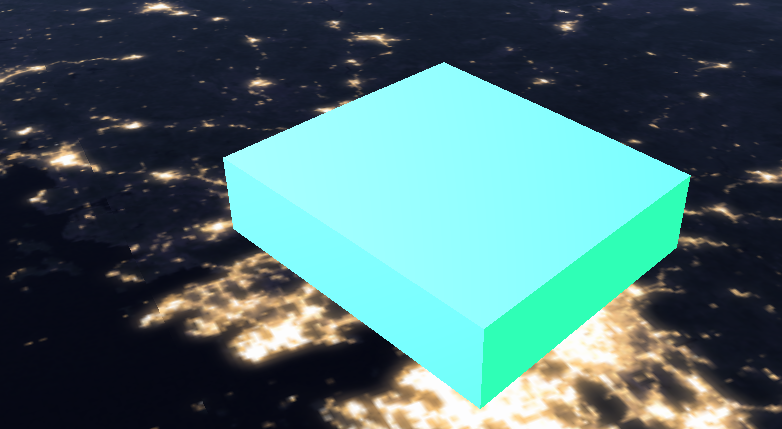
稍微有那麼一點感覺了。
``` JS
const m = new Cesium.Material({
translucent: false,
fabric: {
source:
`czm_material czm_getMaterial(czm_materialInput materialInput)
{
czm_material material = czm_getDefaultMaterial(materialInput);
material.diffuse = vec3(0.24313725490196078, 0.7372549019607844, 0.9333333333333333);
material.specular = 0.5;
material.shininess = 0.8;
material.emission = vec3(0.0, 0.66666666, 0.0);
return material;
}`,
}
});
```
# 3. *高階運用:直接修改 Appearance 的片元著色器
用的是 1. 中的程式碼,修改 aper 物件的構造引數,直接將 2.3 中的片元著色器程式碼貼入看看:
``` js
const aper = new Cesium.MaterialAppearance({
fragmentShaderSource:
` varying vec3 v_positionEC;
varying vec3 v_normalEC;
varying vec2 v_st;
void main()
{
vec3 positionToEyeEC = -v_positionEC;
vec3 normalEC = normalize(v_normalEC);
#ifdef FACE_FORWARD
normalEC = faceforward(normalEC, vec3(0.0, 0.0, 1.0), -normalEC);
#endif
czm_materialInput materialInput;
materialInput.normalEC = normalEC;
materialInput.positionToEyeEC = positionToEyeEC;
materialInput.st = v_st;
czm_material material = czm_getMaterial(materialInput);
#ifdef FLAT
gl_FragColor = vec4(material.diffuse + material.emission, material.alpha);
#else
gl_FragColor = czm_phong(normalize(positionToEyeEC), material, czm_lightDirectionEC);
#endif
}
`
});
```
沒有問題:

所以,基於此模板,只要膽大心細(劃掉)只要對 Cesium 內建的著色器足夠了解,完全可以自己改頂點和片元著色器。
### 試一試:把 2.2 和 2.4 中的嘗試加入
``` JS
const aper = new Cesium.MaterialAppearance({
fragmentShaderSource:
` varying vec3 v_positionEC;
varying vec3 v_normalEC;
varying vec2 v_st;
void main()
{
vec3 positionToEyeEC = -v_positionEC;
vec3 normalEC = normalize(v_normalEC);
#ifdef FACE_FORWARD
normalEC = faceforward(normalEC, vec3(0.0, 0.0, 1.0), -normalEC);
#endif
czm_materialInput materialInput;
materialInput.normalEC = normalEC;
materialInput.positionToEyeEC = positionToEyeEC;
materialInput.st = v_st;
czm_material material = czm_getMaterial(materialInput);
material.diffuse = vec3(0.24313725490196078, 0.7372549019607844, 0.9333333333333333);
material.emission = vec3(0.0, 0.66666666, 0.0);
material.specular = 0.5;
material.shininess = 0.8;
#ifdef FLAT
gl_FragColor = vec4(material.diffuse + material.emission, material.alpha);
#else
gl_FragColor = czm_phong(normalize(positionToEyeEC), material, czm_lightDirectionEC);
#endif
}
`
});
```
# 4. \*\*實驗性記錄:修改 Appearance 的頂點著色器
``` js
const apr = new Cesium.MaterialAppearance({
vertexShaderSource:
`
attribute vec3 position3DHigh;
attribute vec3 position3DLow;
attribute vec3 normal;
attribute vec2 st;
attribute float batchId;
varying vec3 v_positionEC;
varying vec3 v_normalEC;
varying vec2 v_st;
void main()
{
float zh = position3DHigh.z * 0.97;
float zl = position3DLow.z * 0.97;
vec3 th = vec3(position3DHigh.xy, zh);
vec3 tl = vec3(position3DLow.xy, zl);
vec4 p = czm_translateRelativeToEye(th, tl);
v_positionEC = (czm_modelViewRelativeToEye * p).xyz; // position in eye coordinates
v_normalEC = czm_normal * normal; // normal in eye coordinates
v_st = st;
gl_Position = czm_modelViewProjectionRelativeToEye * p;
}
`,
})
```
依舊是上方 1. 的例子,只不過在頂點著色器稍微動動手腳,可達到變形的效果:
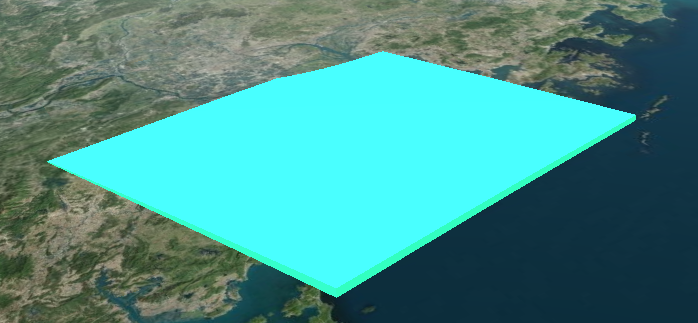
很可惜這個 position3DHigh 和 position3DLow 並不是這個 Primitive 的區域性相對座標,所以直接修改 z = 0 是壓不平的,但是從圖中可略見端倪,猜測這個 z 值是世界座標,後續使用半透明地形看看。
# 5. 給材質的著色器程式碼傳入動態值:uniforms 的運用
`uniform` 在 WebGL 中就是恆定值的意思。一般 WebGL 用 `attribute` 關鍵字指定頂點屬性或外來值,用 `uniform` 關鍵字指定常量,用 `varying` 關鍵字指定頂點著色器、片元著色器共享的變數。
在 Cesium fabric 規則中,fabric.uniforms 的所有變數,在 fabric.source 中可以直接使用。
例如,我需要傳入一個透明度:
``` JS
const m = new Cesium.Material({
fabric: {
uniforms: {
my_var: 0.5,
},
source:
`
czm_material czm_getMaterial(czm_materialInput materialInput)
{
czm_material material = czm_getDefaultMaterial(materialInput);
material.diffuse = vec3(0.5, 0.9, 0.3);
material.alpha = my_var;
return material;
}
`
}
});
```
是可以的:

列印 這個 m變數,可以輕鬆看到 glsl 程式碼:

並且支援直接對 js 的變數進行修改以重新著色:
``` JS
m.uniforms.my_var = 0.9;
```
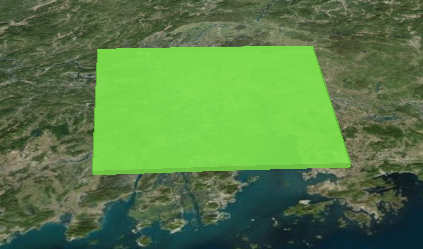
## 注:瞭解 uniforms
uniforms 是 fabric 物件的一個屬性,按理說,你可以給這個物件傳遞任何與 glsl 內建結構、資料型別有對應關係的資料,例如上例的 `my_var`,是數字型別,在著色器內部自動解析為 `uniform float my_var_0;`
參考官方給出的二十多種預置 Material,如果你有興趣,可以直接把它們的 source 打印出來觀察。
例如,在鏡面反射材質中,它的 uniforms 就有這兩個:
``` JS
uniforms : {
image : 'specular.png',
channel : 'a'
}
```
一個是圖片路徑,一個是圖片用於鏡面反射強度的通道(此處是 alpha 通道)。
如果你傳遞的是物件,例如最常見的紋理材質中:
``` JS
uniforms: {
image: 'diffuse.png',
my_struct: {
x: 10,
y: 2
}
}
```
這個 my_struct,最終會傳入一個結構體 `uniform vec2 my_struct_0;`
當然有的時候不要作死,比如這個情況是轉譯不了的:
``` JS
uniforms: {
my_var: 0.5,
my_struct: {
x: 12,
y: 5,
name: {
value: 'aaa'
},
obj: false,
time: 5
}
}
```
會報錯,因為 my_struct 已經超出了 glsl 能理解的型別。
事實上,你在 uniforms 物件中寫的任何資料,在 fabric.components 中一樣能用,並且 Cesium 的內建結構體常量、函式都是可以直接使用的。
從著色器的角度看,一種材質無非就是 `czm_getMaterial()` 函式的返回值罷了。
這裡僅僅改的是材質,屬於片元著色器階段發生的事情,在第四節中已經看到了 Material 中寫的著色器程式碼是如何被 Appearance 物件的片元著色器程式碼呼叫的。如果你想修改 Primitive 的形狀,那就要去修改 Appearance 的頂點著色器。
Primitive 是 Scene 物件下的,在渲染迴圈中它是最終被宰殺的羔羊(劃掉),只要是 Primitive,只要你有能力去修改它的著色器程式碼,就可以自定義很多東西出來。
## 玩一玩:視覺化紋理座標
將紋理座標作為漫反射顏色寫入,就能看到紋理座標的樣子了:
``` JS
const m = new Cesium.Material({
fabric: {
uniforms: {
my_var: 0.5,
},
source:
`
czm_material czm_getMaterial(czm_materialInput materialInput)
{
czm_material material = czm_getDefaultMaterial(materialInput);
material.diffuse = vec3(materialInput.st, 0.0);
material.alpha = my_var;
return material;
}
`
}
});
```
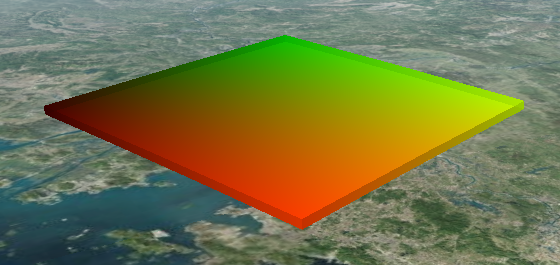
# 6. 後續想做的
- 研究自帶材質的著色器以及最終生成的頂點著色器、片元著色器
- 繼續結合原始碼,研究各路 Primitive
- 研究自帶 glsl 結構體、函式、常量,靈活運用
- 理解頂點著色器的坐
